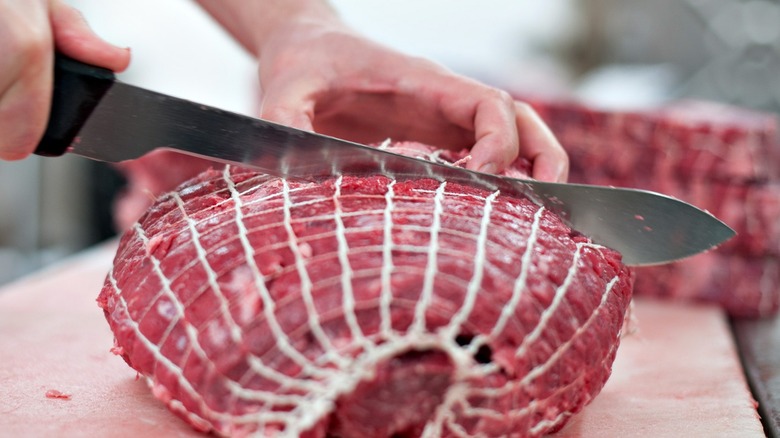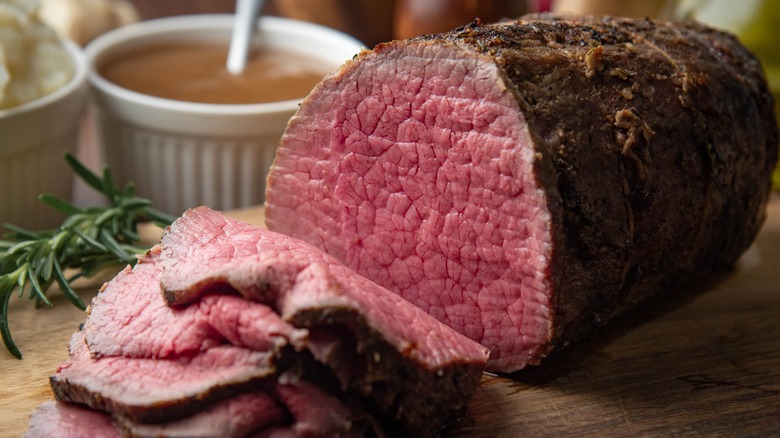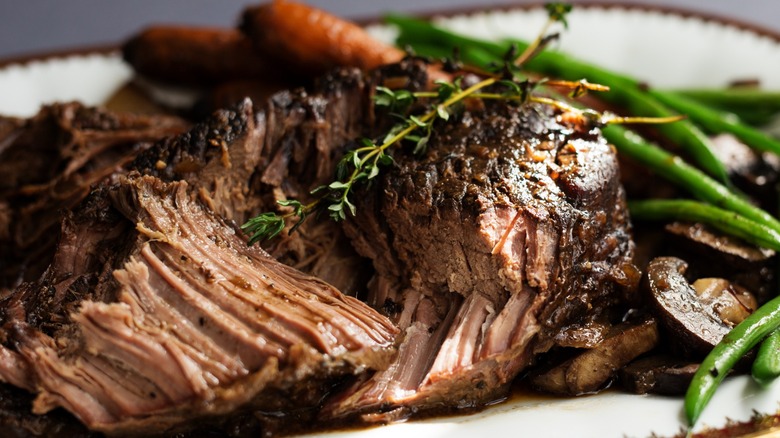The Two Roast Beef Cuts You Definitely Shouldn't Use Interchangeably
It's a common scenario — you're standing in the grocery store's meat department, trying to decide which cut of beef to buy for your roast dinner. Perhaps they're out of the one you came for or there's a sale tempting you with a tasty price, leaving you to wonder what other cuts you could sub in undetected. The options can feel pretty daunting if you don't know much about the different cuts of beef. Sometimes, the similarities between two cuts of beef can lead to confusion, especially when they look or cost relatively the same amount. Let's face it, we're not all butchers.
Case in point are top round and chuck roasts. These large inexpensive cuts of beef can be excellent for your bottom line. But both come with their own unique characteristics and challenges, along with reputations for being tough cuts. Despite their commonalities, these two roasts are not perfectly interchangeable. Understanding their differences is the key to choosing the right one for your desired outcome, as well as how to make the most of each cut, playing to its strengths.
When to use top round roast
Cut from the hardworking hind quarters (the rump and back legs), specifically, the inside back legs, these big roasts are lean and mean with very little fat or collagen to soften up the cut. The powerful muscles in this area are used for movement, so the beef here is leaner and less tender. This is why a top-round roast can be tough if not cooked correctly or when used in a recipe that doesn't work well with its particular idiosyncrasies.
However, it is ideal for those juicy, perfectly pink on-the-inside, thin slices you'll no doubt want to carve up for delicious roast beef sandwiches. And while top round also works excellently for traditional cross-grain, thin-sliced roast beef and Yorkshire pudding-type dinners, it's not the best cut for achieving that fall-apart fork-tender pot roast you've been dreaming about.
For best results, Certified Angus Beef recommends coating your top round with olive oil before applying your spices. Then, pop it into a 450-degree oven for 15 minutes to sear the outside before turning the heat down to 325 degrees for the rest of the time, cooking it low-and-slow for about 70 minutes to achieve medium-rare beef. Alternatively, you can sear it on the stovetop before putting the beef directly into the oven at the lower temperature to cook.
When to use chuck roast
Chuck roast, on the other hand, comes from the front of the cow, specifically the shoulder. It's also a tough cut of beef, with lots of connective tissue. Like top round, it can be saved by low-and-slow cooking times. Its ample collagen and fat content results in a fork-tender roast that shreds easily, with a depth of flavor that can't be beaten. Its easy-shred texture makes it well-suited to classic pot roast, enchiladas, ragus, and shredded beef sandwiches.
While top round and chuck both benefit from low-and-slow cooking times that help to break down their tough proteins, chuck roast is best cooked in a slow cooker or braised in the oven. This allows the fat and collagen to adequately render, infusing the meat and tenderizing it to melt-in-your-mouth succulence. YouTube favorites, The Bearded Butchers recommend seasoning your roast and cooking it in liquid (water or broth) in a crockpot set on low for roughly 10 hours. Feel free to sear, season, and add vegetables to your slow cooker to your specific tastes or recipe.
With these differences at play, if your local grocer or butcher's shop is out of the cut you're looking for, it may very well be better to tweak your dinner plan to accommodate the cut you can find, rather than try to force it. Just remember when it comes to inexpensive and tough beef roasts like these, as The Bearded Butchers like to say, "If it's tough, you didn't cook it long enough."


